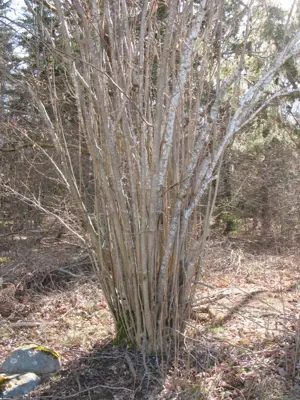
Common Hazel (Corylus avellana L.)
- Hem
- Projekt
- Vilda kulturväxtsläktingar
- Växtporträtt
- Common Hazel (Corylus avellana L.)
Hazelnuts are historically one of the most common nuts in the Nordic countries and our long association with hazel has created several folklore traditions. Hazelnuts ripen in late summer or fall and should be harvested as soon as the edges of the husks that enclose the nut begin to turn brown. Otherwise there is always a risk that you have to compete for them, for example with squirrels. However, one need to be careful, according to UK folklore hazelnuts should never be gathered on Sundays. Then the devil could make you company…

Corylus avellana, growing wild in Europe and southern parts of the Nordic countries, is one of several hazel species all belonging to the Betulaceae family. It is monoecious so male and female flowers are separated but on the same plant. Common hazel flowers very early in spring, before the leaves are visible. It is wind pollinated but because of its early flowering time hazel is important for bees and bumble bees seeking food to feed their larvae. Corylus avellana prefers shady sites and humid, nutritious soils. A single stem can be up to 70 years old but in dense shrubberies it often lives only for 20-30 years. New stems rejuvenate the bush continuously.
Historically hazelnuts were harvested in nature and were a good source of income. During the 16th and 17th centuries hazelnuts were collected in the forests of southern Sweden for export to Germany and Netherlands. After the 18th century people began to harvest more and more only for house needs as the competition from Italy increased. In Sweden historically, hazelnuts have been considered as the landowner´s property. Only exception was on Gotland where it was free to pick for everybody. When the right of public access (allemansrätten) was established in Sweden in the beginning of the 20th century hazelnuts were not included, which shows the historically economic value of these nuts. Besides nut production, Corylus avellana has been of importance as raw material for different types of sticks, stanchions, fences, barrel bands, baskets, wattles etc.

Cultivation and breeding
Cultivation of hazel has taken place in some of the Nordic countries and breeding has been conducted for example in southern Sweden. In the 1920s and 1930s is was performed in Alnarp and in the 1940s and 1950s at Balsgård (both today are part of the Swedish University of Agricultural Sciences). At Balsgård, the breeding goal was to create cold hardy male flowers on plants producing large and smooth nuts. Crosses were performed between Swedish wild plant material surviving the cold winters during 2nd WW and commercial cultivars. Freezing tests showed that wild Swedish hazels could withstand 5-10° lower temperature compared to the cultivars tested. Around 100 seedlings produced by crosses were planted before the program had to close down in the beginning of the 1960s. A huge hazel hedge still growing at Balsgård is a memory of Cultivation of hazel has taken place in some of the Nordic countries and breeding has been conducted for example in southern Sweden. In the 1920s and 1930s is was performed in Alnarp and in the 1940s and 1950s at Balsgård (both today are part of the Swedish University of Agricultural Sciences). At Balsgård, the breeding goal was to create cold hardy male flowers on plants producing large and smooth nuts. Crosses were performed between Swedish wild plant material surviving the cold winters during 2nd WW and commercial cultivars. Freezing tests showed that wild Swedish hazels could withstand 5-10° lower temperature compared to the cultivars tested. Around 100 seedlings produced by crosses were planted before the program had to close down in the beginning of the 1960s. A huge hazel hedge still growing at Balsgård is a memory of the breeding program.
Worldwide Turkey is by far the largest producer of hazelnuts today, whereas Denmark (around 10 ha, 2013) is among the four largest producers in northern Europe. In general, hazelnuts are consumed after drying but in Denmark all cultivation is for fresh consumption of green nuts.
Bonus fact: The nut paste Nutella was invented 1946 by the Italian Pietro Ferrero as a way to eke out the expensive and rationed cocoa beans. One of the main ingredients is hazelnuts. Did you know that it would take 41 923 hazelnuts to cover the circumference of the Colosseum, which is 0,0001 % of the number of hazelnuts used inside all the jars of Nutella sold in a year?
Referenser
Nylinder, B (2013) Nötodling i sydsverige – med fokus på hassel, http://www.permakulturiskane.se/wordpress/wp-content/uploads/2015/03/N%C3%B6todling_i_Sydsverige.pdf (2018-11-30)
Livsmedelsverket, Nötter och frön – råd, https://www.livsmedelsverket.se/matvanor-halsa–miljo/kostrad-och-matvanor/rad-om-bra-mat-hitta-ditt-satt/notter-och-fron—rad#F%C3%B6r%20h%C3%A4lsan (2018-11-29)
Culham Research Group, #Advent Botany, https://blogs.reading.ac.uk/crg/advent-botany-2015-day-4-lore-of-hazelnuts-corylus-avellana/
Did you know – Nutella.
Holmåsen I. (1989) Träd och buskar. Lund, Stenströms Interpublishing AB
Nybom, H. (2006) Växtförädling av Hassel i Sverige. Pomologen 2006. Sveriges pomologiska sällskap


